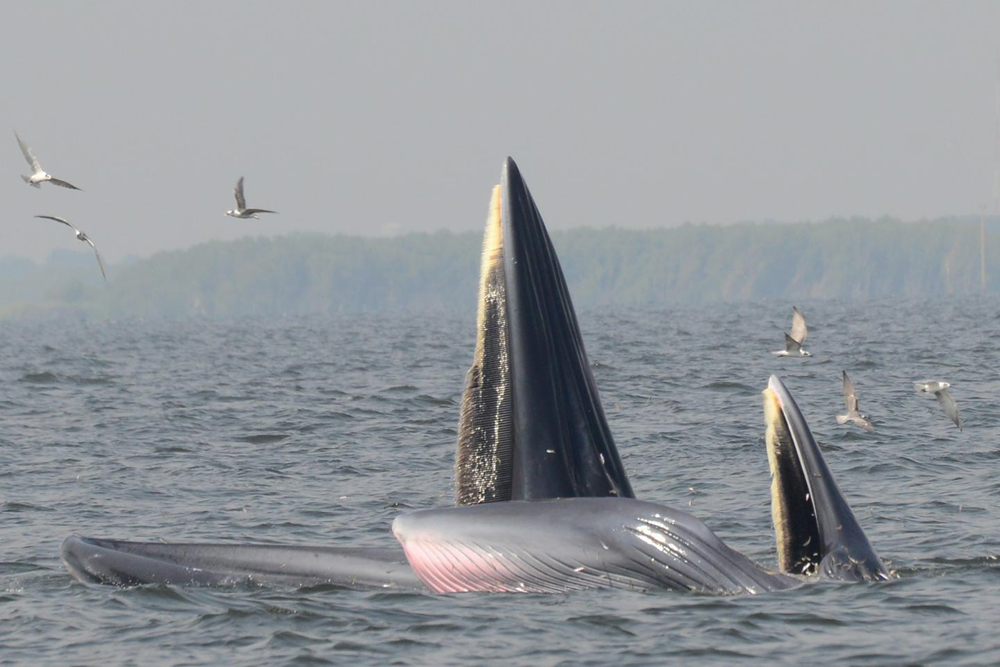Zen Whales Who Let The Buffet Come To Them?
In the Gulf of Thailand, Bryde’s whales sometimes skip the lunging, and just open wide.
By Vicki Croke

An adult Bryde’s whale with calf in the Gulf of Thailand: “Our findings suggest that calves might learn tread-water feeding by imitating adults,” according to lead author Takashi Iwata. “Moreover, because imitation is an important aspect of social learning, the tread-water feeding of the adult-calf pairs in this study implies social learning.” Photo: Takashi Iwata.
In a move somewhat similar to a comedian sitting alongside a conveyor belt in a candy factory who gobbles up mouthfuls of chocolates as they come down the line, researchers have discovered that some Bryde’s whales in the Gulf of Thailand practice passive feeding. They tread water near the surface, keep their mouths wide open for several seconds, and enjoy the anchovies and other small fish that pour in. To scientists, the behavior is more than just a leviathan version of a famous “I Love Lucy” episode. It’s the first time this tactic has been observed in rorqual whales (the largest family of baleen whales) or any baleen whales at all.
Rorqual whales, which also include blue, minke, and humpback whales, among others, are famous for spectacular lunge feeding moves—the high-energy, high-speed maneuvers in which whales shoot forward, mouths opened wide for several seconds, taking in sometimes thousands of gallons of water and many pounds of prey. Through their signature baleen plates, the water is strained out and the bounty of prey (krill, small fish, etc.) is captured.
The Bryde’s whales in the Gulf of Thailand also lunge feed like other whales of their kind. But their additional, more relaxed “tread-water feeding” or passive feeding behavior, had not been observed before, according to researchers whose study appears this week in the journal Current Biology.
Lead author Takashi Iwata, now at the University of St Andrews, has been studying these whales since 2013. “Previously, all studies have shown that baleen whales, including rorqual whales, perform active chasing and feeding,” he explained in a statement and in an email. “We were surprised to find that Bryde’s whales feed on small fish by opening their mouth until the lower jaw contacts the sea surface and waiting for the prey to enter their mouth.”
How different is that passive feeding? Dr. Iwata said, “This behavior is distinct from the typical lunge feeding because the whales do not swim forward in pursuit of prey during the period from mouth opening to closing.” That sounds like an energy saver.
Researchers observed 31 individual whales (including 8 pairs of adults with calves) exhibiting the behavior nearly 60 times. Why is this happening here?
A big part of the picture is that particular conditions in the upper gulf may be driving the scenario. Lots of sewage has reduced the oxygen levels in the water, and may have driven the anchovies toward the surface, and with them, or after them then, the anchovy-eating whales.
So much about the story was surprising to the researchers. First, the fact that the anchovies seemed to so readily go into the mouths of the whales. “When a whale kept its upper jaw above the ocean surface,” according to the group’s news release, “the researchers noticed that many anchovies in the nearby water appeared to lose their sense of direction and, driven by the current, flowed right into the mouths of the whales.”
Then, the whales themselves. Is the behavior a trend? Could it be cultural? It does look to those studying them that the whales are learning how to do it from each other.
“Our findings suggest that calves might learn tread-water feeding by imitating adults,” Iwata said. “Moreover, because imitation is an important aspect of social learning, the tread-water feeding of the adult-calf pairs in this study implies social learning.”
There’s still a lot to figure out.
